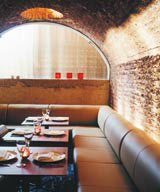Back to nature
Designers are using natural materials to create restaurants to suit every pocket, from gourmet establishments to edgier venues targeted at younger customers. Bethan Ryder investigates

Yet this rawness is never allowed to become too Brutalist. Designers are softening gritty textures with drapes and decorative wallpaper. At Sardo Canale silk curtains that have been hand-screen printed by Timorous Beasties run along walls that contrast with unfinished surfaces, and at Camerino in London’s Conduit Street, red drapes and murals by Gala Fernandez provide flamboyance in a sparse dining room.
Designers of exclusive, formal restaurants are also relying on these theatrical elements, particularly to glamorise basement spaces. But here, red is replaced by rather more elegant cream and white. At Chelsea’s Le Cercle, an exquisite silver floral mural by artist Janet Fryer adorns one wall. Inspired by the rustic French tapas menu, restaurant design veteran United Designers has allowed timber to dominate. The dining room is furnished by curvaceous rosewood Danish chairs (No Moller’s Model 71) and enveloped by diaphanous white drapes, which create privacy for booths and the bar area. The bar-top comprises a thick slab of oak housing an ice-filled recess for bottles. A 17th century stone fireplace provides a country house-style hearth, the rural idyll completed by rugged tree trunk tables and Eames 1945 LCW plywood lounge chairs.
At United’s recently completed Pearl restaurant in London’s High Holborn, walnut timber structures set within a Grade II-listed interior create a rich, contemporary look. (Stiff and Trevillion uses dark ebony macassar veneer in a similar way at its soon-to-open Island Restaurant & Bar, which overlooks Hyde Park). Plundering nature again, but in a more refined way, the pearl theme is executed in details such as tables inlaid with mother-of-pearl and cylindrical chandeliers cascading with transparent beads and pearls. Maintaining a high level of quality, as befitting a restaurant aiming for Michelin stars, United has furnished the dining room with cream leather upholstered chairs.
At Manchester’s Obsidian restaurant in the Arora International Hotel, Julian Taylor Design Associates has also chosen opulent cream leather. ‘We wanted to create an optimistic space, and put a bit of glamour into going out,’ says Julian Taylor. Intentionally ‘showy’, the walls are lined in backlit white drapes, while generously sized tan club chairs from Geometric Furniture provide additional seating. Lighting takes several forms, including white wall screens punctuated by Slits house candles and Kaipo lamps from Moooi, designed by Edward van Vliet. Silvered crystal glass bases add antique-with-a-modern-twist decadence.
Most eye-catching is the bar, ‘a mirror façade with etched horizontal lines to look like layers of ice,’ explains Taylor. The glowing bar remains a current favourite, as designers love to exploit our phototrophic tendencies. Skin restaurant in Nottingham’s Lace Market also stars an internally illuminated glass bar (and cream leather booths) designed by Philip Watts.
All in all, restaurant design may have come down to earth, but judging by the lights, curtains, murals and open ‘show’ kitchens, theatricality is here to stay.
Restaurant Design by Bethan Ryder is published by Laurence King on 31 August, priced £30
-
Post a comment




